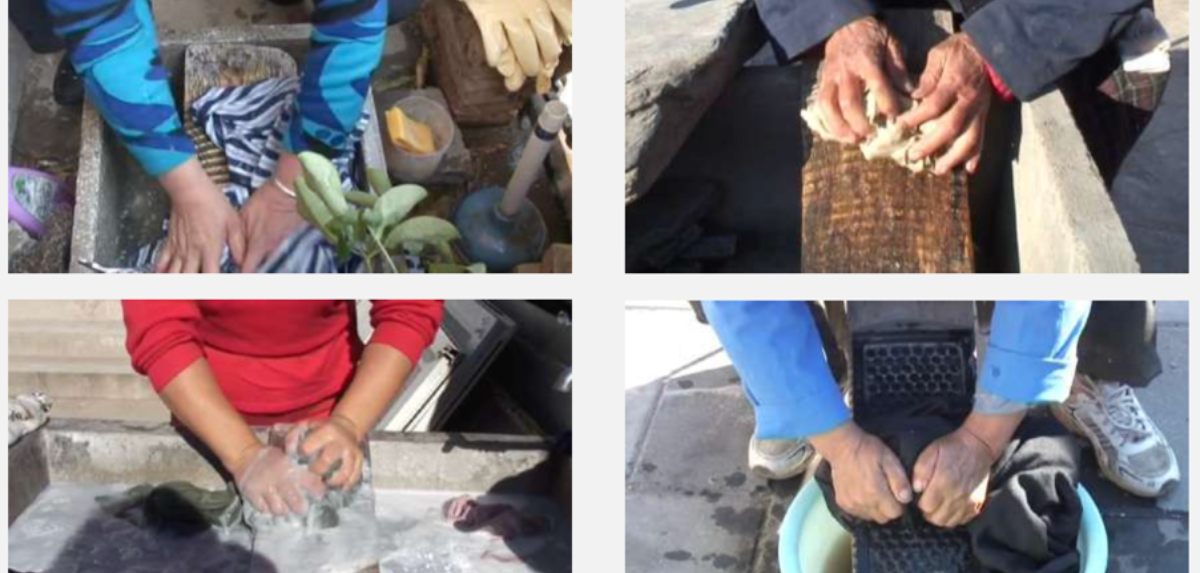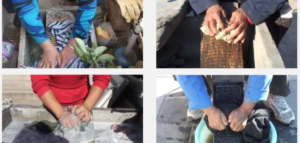Washing in the River, 2008, single-channel video (colour, sound), 3’20”, edition of 2+AP. Image courtesy of artist and Vermilion Gallery, Sydney.
by Jennifer Yang
Two weathered wooden washboards hang beside the doorway of Vermilion Gallery in Walsh Bay. They greet us as if they are ornamental wall-pieces and, for a brief while, we might contemplate them as aesthetic objects; their function is not so apparent in our era of automated laundry machines. Here, they stand-in for their counterparts which live on in Tao Aimin’s (陶艾民) practice. The artist has collected over a thousand washboards from women living in China’s countryside, transforming them into sculptural and two-dimensional works. In Her Secret Code, Tao’s first exhibition in Australia, the arched ridges of the washboard—bearing the unique traces of their former user’s touch—methodically re-appear and haunt the space in imprints and impressions. The washboard is a means to carry the weight of what Nüshu represents to Tao: a lived linguistic code, enacted into existence and sustained through tedious processes of inscription and transcription, and the matrilineal passage of knowledge and texts.
Curator Dr Luise Guest is never didactic. A singular wall text explains that Nüshu is the world’s only script inherited and used exclusively by women. On the other side of the room, a looped slideshow of photographs plays silently from a TV screen. We gather a sense of Nüshu’s history as a script invented by illiterate women from Jiangyong prefecture in China’s Hunan province, far from the country’s urban centres of economic and artistic production. We see the manifold material forms of nüshu, etched onto a bronze coin, embroidered into fabric, and painted onto the opening pages of sanzhaoshu (三朝书) or Third Day Missives, a cloth-bound journal gifted to young brides by their sworn sisters. Tao records this elusive script—and the hidden lives and subjectivities it intimates—with wonderful delicacy. Take a step closer to the hanging scrolls and you might glimpse the faint pencilled lines which tenderly carry the characters. Paper fans contain scenes of women gathering, singing, and eating, and Nüshu texts, painted vertically along each fold. Beside them, the framed ink paintings reveal a distinctly tactile quality to Tao’s practice; ink bleeds into paper under the impression of a washboard, recording each abrasion and groove in the eroding wood.
Upon my request, gallery director Dr Yeqin Zuo pulls a drawer open to find translations of each work’s calligraphy. They clue us into the stories on display: songs, poems, and letters of hope and sorrow, accounts of ordinary life, lamentations for soon to be married women. But the translations are only approximations—it is difficult to express the poetic meanings of Nüshu, an unstandardised script that has been adapted to the local dialect in Jiangyong and the idiosyncrasies of each woman—in Mandarin. There is an intimacy here in the simultaneous act of viewing/translating/understanding: a ‘layering of voices’, as Guest describes, in the multiple (mis-)translations between the original source, the artist, and us. Even so, the unintelligibility of the text and the scissions in our understanding lend power to the original composer(s). We are reminded that resilience and resistance subsist in conditions of precious secrecy, in the kinship shared between women sequestered to the home, in the burying and burning of a lifetime’s work after death, in the opening and closing of a fan.
In such limited space, the exhibition does well to counter an overreliance on spectacle or the simulation of an anthropological “discovery”. If ever we begin to grow overly enamoured with the curious notion of a “secret women’s language”, the washboard intervenes. In Her Secret Code, this intertwining of non-linguistic (washboard) and linguistic (nüshu) codes is carried through three different iterations—the vertical hanging scrolls, the framed ink prints/paintings, and the painted fans. As viewers walk around the space, the faint sound of wet fabrics being scrubbed against washboards emanates from a smaller, inner room of the gallery space; on display also is a video compilation of women washing clothes with bare, calloused hands, often by the riverside. Tao has recorded these monotonous day-to-day practices in almost every imaginable way—they exist in physical, audiovisual, tactile, pictorial forms. There is something rigorous and nearly forensic about her insistence on documenting what has been overlooked in official history. Tao’s considered methodology sets the pulse of the exhibition. The washboard deepens our understanding of nüshu—it is a portrait of a woman; it contains and materialises a lived history of labour.
The judicious selection of works also gestures toward the significance of medium; Tao performs subtle subversions of the classically Chinese artistic languages she draws upon. Invoking the prestige and refinement of traditionally male-dominated art forms (calligraphy, shanshui scrolls, ink, fan painting, printmaking, rubbing), she honours a so-called ‘fly-head-like’ script practiced by illiterate woman in rural China. As if to fully affirm her care and devotion to that which has been neglected or left behind, Tao paints with sumo (leftover or day-old) ink, which is typically avoided as it is said to produce inferior tones. Embedded into Tao’s material process and enfolded into the exhibition thus are questions of what we deem to be historically significant, traditional, or culturally valuable, and who controls such narratives. Tao draws our eyes to the peripheries of mainstream history. Her work seemingly satiates an all-too-prevalent thirst for a dosage of the local/traditional within a “global”/contemporary formula, but not without challenging the assumptions upholding either end of the dichotomy. The melding together of academic and curatorial practice in Guest’s approach gives space for this critical inquiry, allowing the historical, locational specificities of Tao’s practice to preside over superficially applied labels of the “global”, “feminist”, “contemporary”, and “traditional”.
Somewhat serendipitously, Her Secret Code coincides with the exhibition of works by two other contemporary Chinese artists experimenting with calligraphy and unreadable scripts in Sydney. At the Chau Chak Wing Museum, Xu Bing’s Landscript ink paintings (2002) hang on the walls of the China Gallery as part of the exhibition Sentient Paper. In Chippendale, White Rabbit hosts Gu Wenda’s Forest of Stone Steles (Sixth Series) (2017) for Shuo Shu 说书. Xu and Gu, both long-time doyens of the contemporary Chinese art scene, have received much international acclaim for their monumental sculptural installations and experimentations with pseudo-languages and hybridised, nonsensical scripts. At Vermilion, however, Tao Aimin stages an alternative vision and critique of literary tradition; she pushes the boundary of our understanding and the frame of history, and she inserts a feminine subjectivity into our evaluations of language and culture. In Tao’s conceptions, language is anything but monolithic and neutral. It is fraught with contested and untold histories, and, certainly in the Chinese context, it has been governed by the predilects of a patriarchal, Confucian literati culture. But language also transgresses and survives, as Tao shows us, in Nüshu and in an old washboard.

